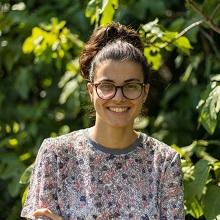Chiara Valzolgher (IMPACT CRNL)
Chiara Valzolgher (IMPACT CRNL)

Sound localization is the ability to identify the location of sounds in space. This skill is extremely important because it allows to perceive the three dimensions of the auditory environment and contributes to attentional orienting and selection. Human learn over the course of life to localize sounds by relying on auditory cues that derive from the interactions of sound waves with the ears and head. Localizing sounds requires creating correspondences between auditory signals and spatial coordinates. Our cognitive system can update these correspondences according to posture and body movements as well as the multiple acoustic scenarios we encounter in life. The other sensory modalities, especially vision, are essential in this updating process. Studying this ability is fascinating for cognitive sciences because it allows to examine the multisensory nature of the acoustic space perception and it permits the investigation of the learning mechanisms subtending these spatial skills. For some people such correspondences are more difficult to create. For instance, people with deafness who use hearing aids or cochlear implants must reconstruct these correspondences through altered and partial auditory cues. For these people, localizing sounds becomes particularly complex and effortful, with disabling consequences in everyday life.
This thesis deals with acoustic space perception and presents a series of original experimental contributions aimed at examining the role of active listening and sound-directed actions in spatial hearing. The first chapter describes the mechanisms underlying sound localization and how they can adapt to altered listening conditions, such as the case of listening with one ear plugged or through cochlear implants. The central chapters of the thesis present a series of experimental contributions – published, submitted, or in preparation - which investigated specific questions about acoustic space perception following an incremental logic. First, I validated the innovative methodology based on virtual reality used in all subsequent experiments of the thesis in people with normal hearing (Chapters 2 and 3). Using this methodology, I tested the ability to locate the sounds in listeners with one ear plugged. Plugging one ear modifies the auditory cues and therefore it constitutes a frequently used model to test adaptation to new auditory cues over time. Second, using this model, I investigated the contribution of multisensory stimulation, feedback and sound-directed actions to the adaptation to altered auditory cues over time (Chapter 4). A further step forward from previous studies was to test the generalization of observed learning effects (Chapter 5). The generalization was first observed in normal hearing with one ear plugged and then in a group people with deafness using bilateral cochlear implants (Chapter 6). In the concluding chapter, the theoretical and applied contributions of the experimental works were discussed. They expand the model of acoustic space relearning already present in the literature (Chapter 7).
This thesis demonstrates the crucial role of active listening in acoustic space perception and relearning. The concept of behavioral strategy is presented as a further component to consider when studying the mechanisms underlying relearning. Furthermore, the crucial role of motor interaction with sounds as a promoter of relearning clearly emerges in this thesis. From an applied perspective, the series of studies presented in the thesis offer a demonstration of the effectiveness of training based on motor interactions with sound in people with bilateral cochlear implants. Starting from the validation of new methodological approach and by testing specific modulations (visual and motor) on the localization of sounds, this thesis dissertation led to the demonstration of the possibility of improving the acoustic perception of people with cochlear implants through a protocol based on sound-oriented actions and active listening, implemented in virtual reality. In this respect, this offers theoretical contributions as well as practical indications for building a training approach that could transfer to the clinical world both for the measurement and for the rehabilitation of auditory spatial skills.
Key words: Acoustic space; Sounds localization; Learning; Head-movements; Virtual reality; Cochlear implant; Multisensory; Hard-of-hearing; Deafness
CRNL - CH Le Vinatier - Bâtiment 462 Neurocampus Michel Jouvet - Amphithéâtre Neurocampus











